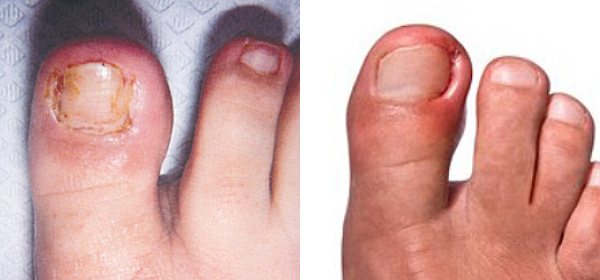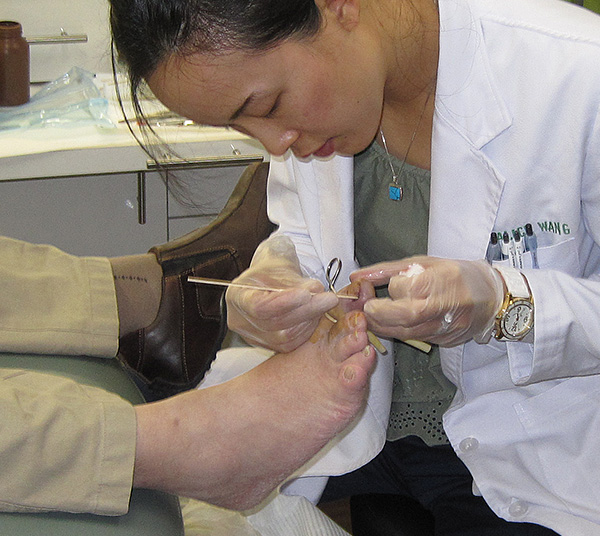Ingrown Nails, one of the most common nail impairment, are nails whose corners or sides dig painfully into the soft tissue of nail grooves, often leading to irritation, redness, and swelling. Usually toenails grow straight out. Sometimes, however, one or both sides of the nail curve and grow into the flesh. The big toe the most common toe to suffer from this condition but other toes can also become affected. If untreated, an infection may occur.

Ingrown Toenails.
Common Causes
- Improper trimming of nails
- Improper footgear including shoes, hosiery, and elastic stockings
- Trauma
- Bunion deformity causing pressure against the 2nd toe
- Repetitive pressure from athletic or work activities
- Fungal infections
- Pregnancy
- Obesity
What you can do at home if you believe you have an inflamed ingrown nail
Immerse the foot in a warm salt water soak, preferably Epsom salt – one tablespoon of salt per liter of water. Soak for 15 minutes twice a day. Then apply small amount of antibiotic ointment to the nail border that is inflamed. Cover the area with a band aid during the day to prevent contamination. Patients with diabetes or poor circulation must avoid any form of self treatment and seek medical care as soon as possible. If the inflammation does not resolve within 24 – 48 hours, or if you have increased pain, drainage, swelling, or redness, you should see a foot doctor right away.
For tips on preventing nail problems in general, please visit our Nail Care page under Foot Care Tips.
How Long Should You Wait To Seek Medical Treatment
You should see a foot doctor as soon as possible. Chronic ingrown nails cause abnormal skin to form around the nail. This abnormal skin may cause recurrent nail infections and make the area more difficult to treat.
How A Foot Doctor Can Help
If you have an infection secondary to ingrown nail, the doctor may prescribe you oral antibiotics. You should avoid any “do-it-yourself” treatments, including any attempt to remove any part of an infected nail. Depending on the severity of the ingrown nail, your doctor may resect a small corner of the nail that is causing the problem or recommend a procedure to permanently prevent ingrown nail from occurring.

Dr. Alice Wang performing an ingrown toenail procedure.
This is typically performed under local anesthetic and most patients tolerate the procedure very well with little pain. Ingrown toenails usually resolve very quickly after the offending portion of the nail is removed. The portion of the nail that is ingrown and thus removed during the procedure is usually small so your nail will look normal once it is healed.
If you are experiencing discomfort due to an ingrown toenail, don’t wait to seek treatment. Often neglecting an ingrown nail can make the problem worse or an infection may occur. A consultation with our knowledgeable foot and ankle specialist will help you determine what the best course of treatment is. Contact us to book your appointment today.

